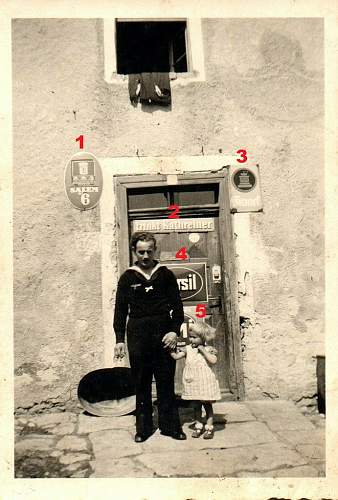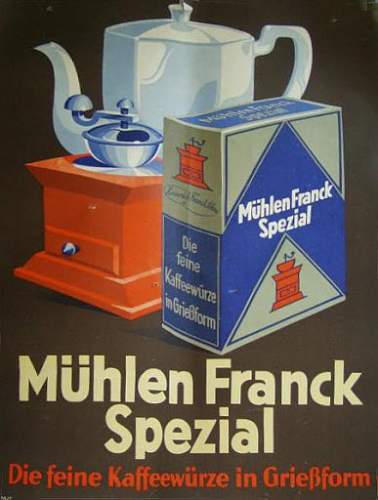
Let's go to the grocery store
So I have named this post of the thread.
We see a photograph of a Kriegsmarine sailor with a little girl at the door of what looks like a small-town grocery store.
If we look closely, we can see no less than five enamel plaques of popular product advertisements.
Let's look at them carefully

Salem nº6
Salem or Salem Aleikum were cigarette brands that appeared at the beginning of the 20th century, produced by the Eastern Yenidze Tobacco and Cigarette factory in Dresden.
One of the most popular of the brand was the "Salem No.6"
The word Salem is based on the Arabic greeting “As Salamu Aleikum”, for the oriental tobacco that was used to make cigarettes
In 1886 Hugo Zietz (1853-1927) founded the Yenidze Oriental Tobacco and Cigarette Factory in Dresden, named after a place in the former Ottoman Empire from which a large part of the tobacco was imported.
The company also became known for its factory built in 1908/1909, which is reminiscent of an Islamic mosque.
Destruction during World War II.
During World War II, about one third of the Yenidze was destroyed. The south wing of the Yenidze was hit by a bomb as part of the extensive airstrikes on Dresden in 1945. The dome was also subject to severe damage. Following an emergency protection measure, the demolished wing of the building was knocked down and partially reconstructed. VEB Importtabak, predecessor of the later VEB Tabakkontor, then moved into the Yenidze and used the building as storage place for raw tobacco, as well as supplying cigarette factories all over the German Democratic Republic.
After World War II, Salem cigarettes continued to be produced from 1947.
Restoration after the German reunification
After the German reunification in 1990, the Yenidze was managed by a trust and eventually sold to a rest estate fund in 1991 which initiated the restoration process according to the requirements of protected heritage. As part of the restoration process, the south wing was refurbished based on the original design. 860 m² of glass were processed for the glazed dome and remodelled according to the original design. In 1997, the Yenidze was reopened as an office facility and now provides a prestigious office location to numerous businesses. The glazed dome houses a restaurant with the highest deck of the city and a 360°view of Dresden
Kathreiner
Kathreiner, with the Kathreiner malt coffee mills subsidiary, was a German group of food wholesale companies originally from Munich.
The best known product was malt coffee. In the late 19th century and into the 1920s they were the largest malt coffee makers in Germany.
The company went bankrupt in 1998
Franck
The Franck brand of coffees and its coffee grinder has been a registered trademark since 1876. It manufactured and distributed coffee substitutes and chicory coffee of multiple varieties.
From the 1920s on, advertising avoided names like: war coffee, which could have evoked poor quality products and cheap ingredients. The new brand "Linde's Coffee Mix" and the "Large Kitchen Mix" were created for the Wehrmacht, which were so successful that Linde's, later simply "Linde", became the main variety in peacetime after 1945 and in the economic boom of the 1950s.

Persil
Persil is a detergent brand of the German multinational Henkel that markets in Germany, Mexico, the United States, Portugal and the Netherlands after acquiring the rights from Unilever in 1919.
The German company Henkel invented a washing powder in 1907 that it marketed under the brand name Persil. The name comes from two of the original ingredients: perborate and silicate.
Persil was not made during WWII, as the Reich government issued an ordinance at the outbreak of war that prescribed a uniform detergent.
Today, Persil is the best-selling laundry detergent in Germany
His most famous advertisement is the one on the roof of the Wilhelm Marx Haus building in Düsseldorf.
Wilhelm Marx Haus
Another thing is Persilschein
The term originated in the German military and refers to Persil washing powder. For example, it was common for army recruits to have to bring an empty box with them to the barracks in order to send their civilian clothes home to their family. Boxes advertising the very common washing powder, Persil, were often used for this purpose.
In soldier's jargon the actual conscription order was also called a Persilschein. After the war, its meaning changed; for a German to be given a Persilschein meant to be given a certificate that they had a clean political past.
The term Persilschein underwent a change of meaning, especially during the denazification period. Suspected Nazi offenders could be exonerated by statements from victims or former enemies and thus accepted as having a good reputation, a record of which was sufficient to meet Allied requirements under post-war denazification laws.
Colloquially the affected person was said to be "washed clean" of accusations of Nazi sympathies; "cleanliness" in this context meaning "innocent". They were attested as having a so-called "white vest" and were now allowed to apply for a house or open a business again.
During 1948, the interest of the Americans in systematic denazification waned markedly as the Cold War and the threat from the Soviet bloc hove increasingly into view. Faster processes were introduced to bring denazification to a swift conclusion, however, that led to questionable judgements
IMI
IMI was from 1929 to 1999 a detergent brand of the Henkel Group. IMI is considered to be the first laundry detergent to contain sodium phosphate
IMI was used especially for heavily soiled work clothes. The phosphate content was higher than in the heavy-duty detergents that were introduced later.
IMI was also used as a floor cleaner, dissolved in a bucket of water; and also as a dishwasher detergent. So it was actually a universal detergent
In 1932, the Goethe and Schiller monuments in the city of Weimar were cleaned up with IMI.
Similar Threads
Bookmarks